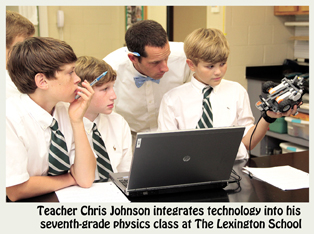How to Integrate Technology in the Classroom
 If you want to see integrated technology in education in action, stop by The Lexington School.
If you want to see integrated technology in education in action, stop by The Lexington School.
Drop into Chris Johnson’s seventh grade physics class and you’ll find students grouped in teams of three over a lab table working with computerized sensors measuring the motion of a coffee filter while videoing the experiment as they go.
The students will upload their data to a shared Google document, one they can see on the classroom’s smart board.
As they load their data, they see it benchmarked with their peers, watching as medians change, looking for an outlier, finding truth in their measure-ments.
Next, watch them imbed their video in the group’s Powerpoint presentation as a vehicle for instructing fellow students.
Or you could observe Dr. Cooper’s music students create their own “Twilight Zone” episodes that they have written themselves.
Students compose the music on the studio Yamaha keyboards, co-write their scripts, produce, direct, film and edit a complete “Twilight Zone” for the modern age, iconic title music now understood and appreciated.
Just across the hall, you can find Sarah Heller’s art classes enthralled with 3-D printing.
As Admissions Director Beth Pride says, “That is integrated technology.”
“We have done this in a thoughtful, comprehensive way that matches our mission of teaching 21st century, non-cognitive skills,”
Those skills are teamwork, creativity, ethics, resilience, curiosity and time management, which are incorporated into all aspects of instruction.
And it doesn’t matter which computer platform students use to accomplish their goals.
That’s the conclusion reached by Jaime Lassman, the school’s Director of Studies who led a team of faculty in researching the ways schools best used technology before TLS adopted what he calls the Bring Your Own Device plan.
(Note – computing learning devices only. No phones allowed in the classroom).
Most schools choose one of two paths – students bring in their own devices or everyone works on laptops, Chromebooks or iPads issued by the school.
TLS does both.
Along with computer labs, the school has two laptop carts, two iPad carts and three Chromebook carts.
When the educational need is best served by everyone using the same device, that option is open.
“We want our students to have experience in different operating systems so that wherever they go they will be familiar,” Lassman said.
“The goal at TLS is to integrate technology such that it allows for a depth of understanding of content while encouraging creativity and inspiring curiosity in our students.”
Lassman, in his 10th year at TLS, teaches students about copyright, plagiarism, fair use and above all how to be safe on the Internet.
That serves the school’s goal of creating digital citizenship, which embraces ethics, a key component to building strong character.
That’s an educational goal for any century.

